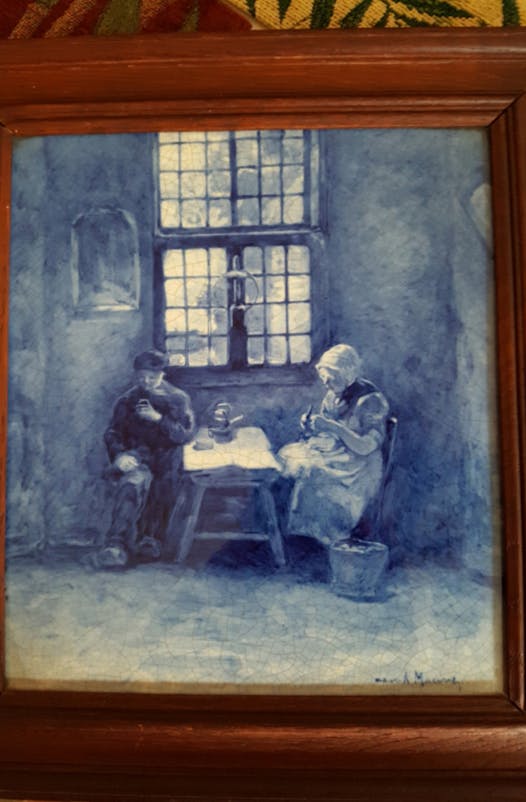Q: This vase was given to me by my mother-in-law. On the bottom it says the piece was designed by Walt Disney in 1940 and made by Vernon Kilns. We tried to sell the piece through a large New York City auction house with no success. Hope you can help us.
A: We discussed this exact piece of pottery some 18 years ago in July 2001, and all we can say is that times have truly changed. At that time, we suggested that the piece might be rather expensive — but unfortunately, markets and collector interests have evolved during the intervening years.
The story of Vernon Kilns starts in 1912 with George Poxon founding Poxon China on a piece of property that was part of the Furlong Ranch in Vernon, Calif., which is located on the southern edge of Los Angeles. Poxon was a graduate of Staffordshire Technical College in England and his forte was glazing.
Poxon started out making small tiles and some art pottery but moved on to hotel and restaurant ware around the beginning of World War I. In 1931, the Great Depression caused Poxon to sell out to Faye G. Bennison, who changed the name of the company to Vernon Kilns (sometimes known as "Vernon Potteries").
For the first few years, Vernon Kilns used Poxon's old stock and decorated it with decals, many of which had a Mexican theme. It is said that many of these were used as premiums in sacks of tortilla flour. Then in 1933 it is reported that an earthquake hit the area and the old Poxon stock was destroyed, and Vernon Kilns had to start afresh.
We are not going to explore all the art wares Vernon Kilns made in subsequent years or discuss the attractive dinnerware it created. Instead, we are going to focus on Walt Disney, who signed a contract with Vernon Kilns on Oct. 10, 1940, to design figures based on Disney's movies — "Dumbo," "The Reluctant Dragon" and "Fantasia."
The figures made by Vernon Kilns were produced from the actual models used in making the films. They are marked in black ink and copyrighted either in 1940 or 1941 and each has a style or stock number (8, for example, is a reclining sprite while 15 is a 6-inch unicorn). These figures originally sold for only $1 to $2.50 but were soon discontinued because of high production costs.
In 1942, the Disney contract was sold to American Pottery, which made a few pieces from the series that were marked with a paper label. These paper labels were easily removed, and it is assumed that unmarked "Fantasia" and "Dumbo" figures were made by American Pottery. It should also be noted that Vernon Kilns made "Fantasia"-themed bowls, vases and dinnerware.
The piece in today's question is 127 and is known as the "Pegasus vase" or in some cases the "Pegasus planter." We found one that sold at Treadway Toomey Auctions in Oak Park, Ill., in 2011 for $100. One also sold at Randy Inman Auctions in Waterville, Maine, in 2005 for $250 — which suggests the downward price spiral of this piece.
Delft tile
Q: I have an item that may be of value and am reaching out for your professional opinion. My grandmother gave me this Delft tile. It is 8 by 10 inches, in an antique walnut frame, and is signed "A. Mauve" for painter Anton Mauve. Thank you for your feedback.
A: This lovely blue and white porcelain plaque was made by De Koninklijke Porceleyne Fles (sometimes called "Porcelain Fles" or "Royal Delft"), which has been located in Delft, Holland, since 1653. The term "Porceleyne Fles" means "the porcelain jar."
The company was reportedly founded by David Anthonisz van der Pieth in his home, but the business has changed hands with some frequency over the centuries. In 1876, the factory was taken over by Joost Thooft, who wanted to repopularize the famous Delft blue and white ware, and the piece is an example of that effort.
Royal Delft is still in business and is the only surviving Delft factory out of more than 30 that were established in the 17th century. The product called Delft is earthenware covered with an opaque white glaze made using tin oxide that is usually called a tin glaze.
You sent photographs of the back of the piece, and below the factory marks are the mark of the painter and a date letter. No, this charming genre scene of the inside of a Dutch home was not painted by Anton Mauve (1838-1888), who was a realist and an important early influence on Vincent van Gogh.
Mauve was known for his realistic depictions of outdoor scenes (sheep, cows, horses), but he also painted some domestic scenes very similar to the one found on the plaque in today's question. But there are two major flaws with the notion that Mauve painted the piece himself.
The first is there is no record (that we could find) of Mauve ever having done work for Royal Delft. The second is this particular tile appears to have a date letter on it (a "T"), which was the code the company used for items made in 1898, or 10 years after Mauve's death.
The image on this piece would be termed "after Anton Mauve" and is not as detailed or as elaborate as some Royal Delft genre and landscape pieces can be. The plaque does appear to be in its original frame, and at auction, we feel it should bring between $750 and $1,000 and be insured for $2,000.
Helaine Fendelman and Joe Rosson have written a number of books on antiques. Do you have an item you'd like to know more about? Contact them at Joe Rosson, 2504 Seymour Ave., Knoxville, TN 37917, or e-mail them at treasuresknology.net.


